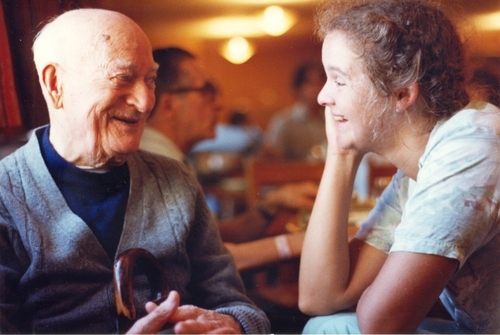Hendy, Robert Ian: my Navy recollections (May 11, 1985)
Interviewer: Lawrence, Hal
ABSTRACT: Cmdre. Robert I. Hendy Royal Canadian Naval Volunteer Reserve (Cassette 1, Side 1) Appointed midshipman RCNVR in August 1936 in the Toronto Company. Comments on officers and training. Summer training in Halifax. Acting Sub-Lieutenant in 1938. Went to sea for five weeks in HMCS St. Laurent. Mentions he obtained his watch-keeping ticket in HMCS Assiniboine in 1939/40. Immediately prior to war completed seven weeks in HMS Berwick (cruiser). At Sydney, Cape Breton helped set up the Naval Control Service where homemade depth charged were made from dynamite in milk cans for use in local patrol craft. Helped establish the Port War Signal Station. Joined Assiniboine in December 1939 and sailed for the Caribbean under Cmdr. Rollo Mainguy. Mentions the capture of the German merchant ship Hanover with the British cruiser HMS Dunedin. Returned to Halifax, April 1940, and a new captain (Capt. G.C. Jones) who was also Senior Officer, Halifax Force. Anecdotes. Hendy took the Long Gunnery Course (of five months duration) and joined the course as an instructor for a short time until appointed to HMS Revenge (battleship) as an assistant gunnery officer for six months (1941). In December 1941 was re-appointed to the Gunnery School in Halifax. After ten months joined the staff of the Director of Naval Ordnance in Ottawa. Lawrence interjects here: an account of the sinking of U-501 whose captain jumped aboard HMCS Moosejaw claiming to surrender. He was later returned to Germany in a prisoner exchange, court martialed and shot. Hendy participated in the re-arming of HMCS Prince Robert (AMC) as an anti-aircraft cruiser and became Gunnery Officer in the ship. Operated in the anti-aircraft role in convoys to Gibraltar and through the Mediterranean to Italy. Only under attack once (Bay of Biscay). In April 1944 sent to the Naval Staff College at Greenwich for ten weeks. Appointed Staff Gunnery Officer, Warfare and Training (Ottawa). (Cassette 1, Side 2) Discusses the arming of the Canadian Tribal destroyers, then building. Post-war naval planning. Comments on Canadian desire for a "big ship" navy. Left the navy in Sept. 1945 as a Commander and Deputy Director of Warfare and Training to go to law school. Re-joined the Naval Reserve as Training Commander (HMCS York) and four years later became Captain and Senior Naval Officer Toronto Area and later the first RCNVR officer to be appointed Commodore in peace time. Comments on Unification in some detail. The plan, despite much effort by TRIO, a group of all the services opposed to Unification, finally realized that the Minister (Paul Hellyer) had more or less boxed himself into a corner and politically was unable to change it without ruining his career. In the end the Navy felt very hard done by. Some additional comments on the defence establishment and the Navy in particular, during financial cut periods. The TSS concludes with a handwritten page by Hal Lawrence.
An interview/narrative of Robert Ian Hendy's experiences during World War II. Commodore Hendy served with the Royal Canadian Navy and the Royal Canadian Naval Volunteer Reserve. Interview took place on May 11, 1985.
Interviewee: Hendy, Robert Ian
Rank: Commodore.
- In Collection:
- 2 sound recordings (MP3)
- 51.5, 10.5
- Original sound recording on one audio cassette also available.
- Canadian Military Oral History Collection
- HRI_273
- Special Collections Finding Aid: https://search.archives.uvic.ca/hal-lawrence-collection
- February 12, 2014
- Digital sound recording in .wav format at 16 bits and 44 kHz. In .mp3 format at 56 kbps and 24 kHz. Digitized by JF, technical and cataloguing metadata provided by JF and JP. Interview migrated to digital format for UVic Special Collections in 2014. Migration metadata by KD and MT.
- Rights
- This interview has been posted with the understanding that it may be used for research purposes only. Should the interviewee or their heirs have any objections to this interview being accessible on the Internet, it will be removed promptly. Contact UVic Special Collections for permission if using for other than research purposes: speccoll@uvic.ca
- DOI
